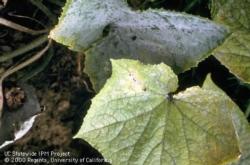Monthly Tip
Powdery Mildew
Tip description

Powdery mildew on squash leaves
Powdery mildew likes warm days and cool nights. Unlike most other fungi, it does not need moisture to thrive. Early symptoms include yellow chlorotic spots on the leaves. The presence of the fungus becomes obvious as it starts to produce spores that look like white powder on leaves. Eventually, the leaves will turn brown and dry. The best defense is to plant varieties that are resistant to powdery mildew. Also helpful is planting in full sun with good air circulation through the plants. Washing off the leaves, preferably in the morning, can buy some time. Powdery mildew generally affects the older leaves first, and you can remove these when they are too covered to be able to photosynthesize. Fungicides can help but you want to be careful about using them around something you are going to eat. At some point, the plant may decline so much that it needs to be removed. More Information: Powdery Mildew on Vegetables
Months applicable
Category
|






